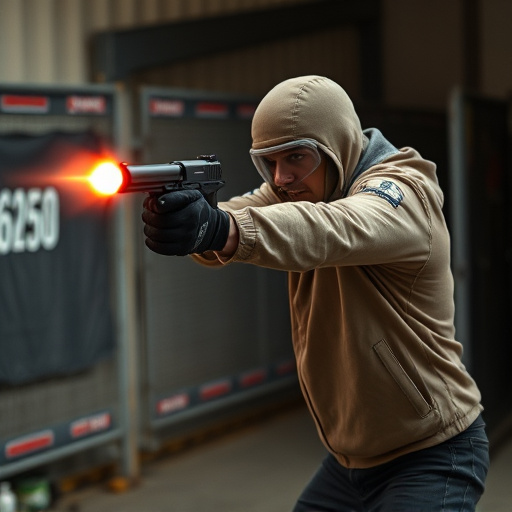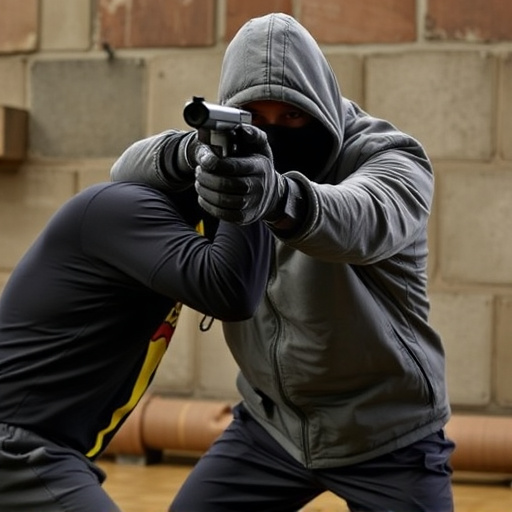Stun devices operate by delivering high-voltage, low-current electrical pulses through metal probes, causing temporary paralysis. Modern stun guns prioritize compactness, lightweight design, and simplicity for easy carrying and one-handed use, enhancing personal safety and peace of mind. When purchasing, focus on ergonomic features, secure grips, and intuitive activation mechanisms to ensure quick deployment and control in emergencies.
Electrical current is the lifeblood of stun devices, enabling their effectiveness as personal defense tools. Understanding how this flow of electrons works is key to comprehending these devices’ functionality. This article demystifies the process, delving into the fundamental principles behind electrical current, exploring its facilitation through stun guns’ unique components and design, and emphasizing safety features that make modern stun devices easy to carry and use. Learn how to choose the right stun gun based on portability and simplicity for maximum peace of mind.
- Understanding Electrical Current: The Basis of Stun Device Functionality
- Components and Design: How Stun Guns Facilitate Current Flow
- Safety Features: Ensuring Easy Carry and Use While Maintaining Control
- Choosing the Right Stun Gun: Criteria for Ease of Carrying and Operational Simplicity
Understanding Electrical Current: The Basis of Stun Device Functionality

Understanding Electrical Current: The Basis of Stun Device Functionality
Electrical current, a fundamental concept in physics, is the flow of charged particles through a conductor. In the context of stun devices, this flow is harnessed to deliver an electric shock, temporarily disabling or disorienting the target. Stun guns, for instance, use electrical energy to create a high-voltage, low-current pulse that disrupts muscle control in the body, causing severe pain and temporary paralysis. This makes them effective personal defense tools, especially when considering the ease of carrying and using modern stun devices.
The key to their functionality lies in the balance between voltage, current, and resistance. Stun guns are designed to produce a high voltage, ensuring that even a low current can still cause significant discomfort or incapacitation. This is particularly important for compact stun devices, which must pack powerful electrical performance into a small, portable form factor, making them easy to carry for personal safety.
Components and Design: How Stun Guns Facilitate Current Flow

Stun devices, commonly known as stun guns, are designed with a specific purpose: to facilitate the flow of electrical current for incapacitating an assailant temporarily. The components that make up these devices play a crucial role in achieving this. Inside a stun gun, you’ll find several key parts: two metal probes, a high-voltage power source, and a control mechanism. When activated, the stun gun creates a circuit by closing the gap between the probes, allowing a powerful electric current to flow through.
The design of these devices is tailored for ease of use and portability, encouraging individuals to Buy stun guns that are easy to carry and use in emergency situations. The compact size and simple activation mechanism ensure users can respond swiftly when faced with potential threats. This accessibility is a game-changer, empowering folks to take control and protect themselves effectively.
Safety Features: Ensuring Easy Carry and Use While Maintaining Control

Stun devices designed for personal safety should prioritize ease of carry and use, without compromising control. This means choosing models that are compact, lightweight, and ergonomically designed. A secure grip and a simple, intuitive activation mechanism ensure users can deploy the device quickly when needed. Additionally, consider stun guns with features like one-hand operation, allowing for easy access and use in emergency situations.
When buying, opt for stun guns that seamlessly integrate safety features without complicating their functionality. These devices should include safety locks or mechanisms to prevent accidental activation, ensuring the user has complete control over when the current is discharged. Such thoughtful design not only makes self-defense more accessible but also enhances the overall safety of the user.
Choosing the Right Stun Gun: Criteria for Ease of Carrying and Operational Simplicity

When buying a stun gun, ease of carrying and operational simplicity should be top priorities for users who want a reliable self-defense device. The best stun guns to buy are those designed with compact sizes and lightweight builds—features that make them easy to slip into pockets or purses without adding significant bulk. Look for models with simple activation mechanisms, such as a single-trigger switch or thumb-activated design, ensuring quick and effortless deployment during emergencies.
Moreover, consider stun guns with built-in safety features like automatic shut-off functions after prolonged use and durable construction to withstand regular carry and occasional rough handling. These factors contribute not just to the convenience of carrying but also to the overall reliability and performance of the device when needed most.
Stun devices, powered by electrical current flow, offer a means of self-defense that leverages science for safety. By understanding how these devices function, from the basics of electrical current to their intricate components and safety features, users can make informed decisions when choosing the right stun gun. Look for models that prioritize ease of carrying and use, ensuring you’re prepared in any situation while maintaining control. When buying a stun gun, consider those designed with simplicity and portability in mind, allowing you to stay safe with confidence.
